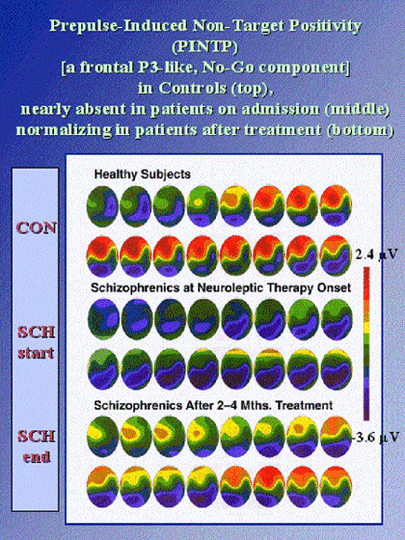|
BENDER, S., SCHALL, U., WOLSTEIN, J., GRZELLA, I., ZERBIN, D. & OADES, R.D. (1999). A topographic event-related potential follow-up study on 'prepulse inhibition' in first and second episode patients with schizophrenia Psychiatry Research Neuroimaging, 90, 41-53. (request a copy) In accord with our understanding of journal policy,
we present the
pre-publication text (view). Introduction: Dopamine agonists impair and antagonists normalise prepulse inhibition (PPI) of startle and gating of the P50 event-related potential (ERP), but the within-subject effect of treatment on impaired gating in schizophrenia has not been studied. We report here the first results of a longitudinal study using PPI of ERPs as a measure of sensory gating in an auditory Go/no-go discrimination. Methods: After admission and about 3 months later, at discharge, 15 patients with schizophrenia performed a discrimination between a 1-4 KHz target tone and an 0.8 KHz non-target tone a) with no prepulse, b) with a prepulse at either 100 ms or 500 ms before either tone. ERP topography was recorded from 19 electrode sites on the scalp. Healthy control subjects were studied twice, with about 3 months between sessions.
Gating of the P50 ERP-peak in the 100 ms-prepulse condition was reduced in patients, on admission. At discharge there was some normalisation with a decrease of negative symptoms correlating with the enhancement of the gated P50 component. An increase of the gated N100 component at centro-temporal sites after treatment correlated with fewer positive symptoms on PANSS ratings.
Conclusions: Weak auditory prepulses interfere with early auditory stimulus processing (e.g. P50), channel selection (e.g. N100) and selective attention (e.g. P300). Gating of these stages of information processing is impaired in psychotic patients and treatment tends to normalise gating in part, in tandem with improvements of different types of clinical symptoms. After our initial report on the Go/no-go
gating paradigm (1993),
subsequent reports concentrated on the
"qualified" presence of the gating effect in OCD
and its attenuation in schizophrenia (P50, N1, P3)
(1996),
Data for OCD patients and the lateralisation
of the N1 impairment in schizophrenia was described in 1997
and the improvement of gating (P3 / PINTP component)
along with Tower-of-London performance in OCD patients in 2001.
|


